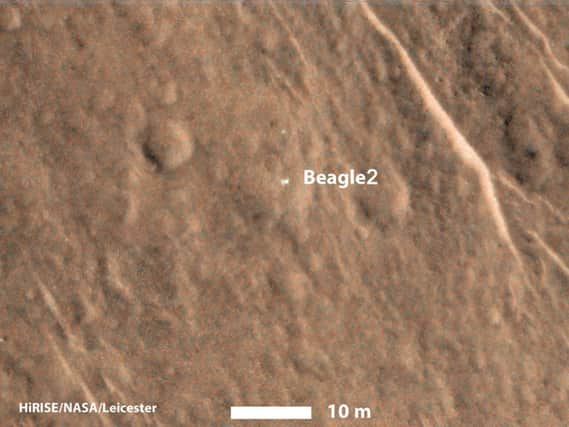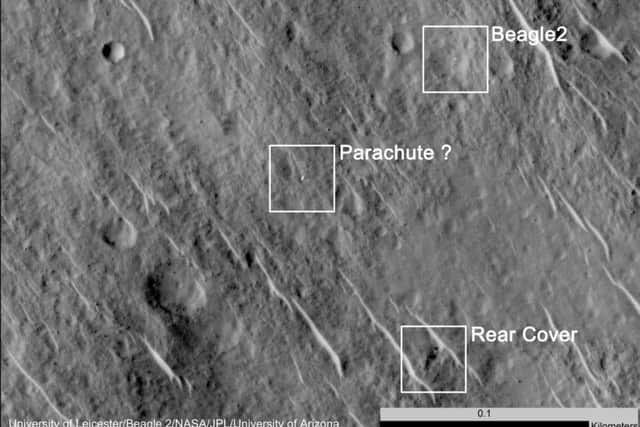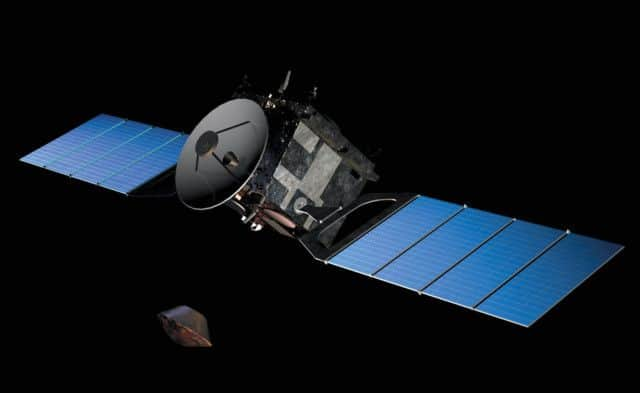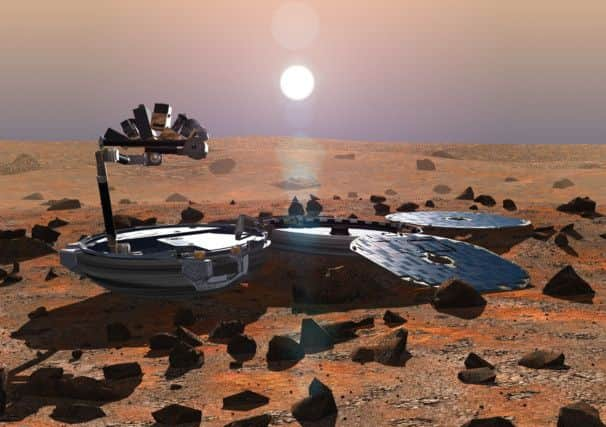Vanished British spacecraft is found on Mars


The Beagle 2 probe has not been seen or heard from since December 2003 and had been presumed destroyed.
But UK Space Agency chief executive David Parker said today that high resolution pictures taken by Nasa’s Mars Reconnaissance Orbiter spacecraft showed it actually successfully landed 12 years ago.
Advertisement
Hide AdAdvertisement
Hide AdDr Parker said: “The history of space exploration is marked by both success and failure. This finding makes the case that Beagle 2 was more of a success than we previously knew and undoubtedly an important step in Europe’s continuing exploration of Mars.”


Mr Parker told a press conference in London: “What we can say with some confidence today is that Beagle 2 is no longer lost and furthermore it seems we are not looking at a crash site.
“We have good evidence of Beagle 2 resting on the surface of Mars.
“These images are consistent with the Beagle 2 having successfully landed on Mars but then only partially deploying itself.”
Advertisement
Hide AdAdvertisement
Hide AdThe agency said the images “identified clear evidence for the lander and convincing evidence for key entry and descent components on the surface of Mars”.


Professor Mark Sims of the University of Leicester, who was an integral part of the Beagle 2 project, said: “I am delighted that Beagle 2 has finally been found on Mars.
“Every Christmas Day since 2003 I have wondered what happened to Beagle 2. My Christmas day in 2003, alongside many others who worked on Beagle 2, was ruined by the disappointment of not receiving data from the surface of Mars.
“To be frank, I had all but given up hope of ever knowing what happened to Beagle 2. The images show that we came so close to achieving the goal of science on Mars. The images vindicate the hard work put in by many people and companies both here in the UK and around Europe and the world in building Beagle 2.
Advertisement
Hide AdAdvertisement
Hide Ad“The highly-complex entry, descent and landing sequence seems to have worked perfectly and only during the final phases of deployment did Beagle 2 unfortunately run into problems. I view it as a great achievement that the team built Beagle 2 in a little over four years and successfully landed it on the surface of Mars.


“It was a great pity we couldn’t have delivered the world-class science Beagle 2 may have brought and even sadder that Colin (Pillinger) and other colleagues who died in 2014 didn’t live to see the discovery that Beagle 2 made it to Mars.”
Because of the partial deployment, it will not be possible to recover Beagle 2 and its data.
Prof Sims added that the images showed it landed but then failed to fully open.
Advertisement
Hide AdAdvertisement
Hide AdThe lander was shaped like an old-fashioned pocket watch with leaf-like panels.
He said their analysis showed that not all the four panels opened, either because of a mechanical fault or because a landing airbag got stuck around it.
Without all four open, it could not communicate with Earth.
Dr John Bridges, of the University of Leicester, said the Reconnaissance Lander’s HiRISE camera spotted the lander from 185 miles above Mars, just three miles from its intended landing site. It found three objects, believed to be the lander and its landing equipment.
They “glinted” in the sun but cast no shadow, he said, adding: “This is not just a pile of rocks and sand on the Martian surface. This is an alien object, a man-made object.”
Advertisement
Hide AdAdvertisement
Hide AdNamed in honour of Charles Darwin’s famous ship, Beagle 2 was a unique space mission in that it was largely funded by private donations and money raised by promotional campaigns led by the late Prof Pillinger.
The probe was carried by the Mars Express spacecraft, which was blasted into space by a Russian rocket from Kazakhstan in June 2003.
The mission’s call-sign was composed by the Britpop band Blur, and the “test card” used to calibrate the probe’s cameras and spectrometer instruments after landing was painted by Damien Hirst.
It was scheduled to put down in a near-equatorial region of Mars known as Isidis Planitia on December 26. But after detaching from the Mars Express and heading for the surface, it was not heard from again.
BEAGLE 2 TIMELINE
Advertisement
Hide AdAdvertisement
Hide AdThe fate of the Beagle 2 Mars lander has been a mystery since it was last heard of on December 19, 2003 as it headed for the surface of the Red Planet.
This is the timeline of events from its launch:
2003
April 13: Beagle 2 arrives at the Baikonur spaceport in Kazakhstan.
May 19: The official countdown to the launch of the European Space Agency’s (ESA) Mars Express begins in London. Science minister Lord Sainsbury switches on a giant digital clock at the Royal Society precisely two weeks and four hours before blast-off.
June 2, 6.45pm UK time: A Russian Soyuz-Fregat rocket launches Mars Express into space, with Beagle 2 loaded on board. About two hours later mission controllers confirm that the spacecraft has successfully left Earth’s orbit.
Advertisement
Hide AdAdvertisement
Hide AdJune 5: Beagle 2 passes its first big test when explosive bolts clamping it to Mars Express are fired and released. The bolts were there to prevent the craft being shaken about and damaged during the launch.
October 28: Mars Express is blasted by radiation from a powerful solar flare which temporarily knocks out its navigation systems. Beagle 2, which was designed to be radiation-proof, was unscathed. The same solar storm damaged Nasa’s Mars Odyssey spacecraft and forced a Japanese mission to Mars, Nozomi, to be abandoned.
November 11: A rocket thrust sends Mars Express on its final course to the Red Planet, 12.5 million miles away.
December 3: Mission controllers say they have received pictures of Mars taken by Mars Express from a distance of 3.36 million miles. The pictures were taken to test the orbiter’s high resolution camera which will capture close-up images of the Martian surface.
Advertisement
Hide AdAdvertisement
Hide AdDecember 19: Scientists nervously wait for the “spin-up and eject” manoeuvre that will separate Beagle 2 from Mars Express and put it on course for the landing. A spring mechanism will push the craft out and at the same time send it spinning to keep it stable. If the separation fails, the mission is over.
• At 10.40am UK time scientists at the European Space Operation Centre in Darmstadt, Germany confirm The Beagle 2 spacecraft has separated successfully from its mother ship.
December 23: Bookmakers Ladbrokes cuts the odds on the spacecraft finding signs of life on Mars from 33-1 to 25-1 after a number of bets were placed.
December 24: Beagle 2 glides through space at more than three miles a second as it completes the final leg of its journey to Mars.
Advertisement
Hide AdAdvertisement
Hide AdDecember 25: At 6.20am scientists wait in vain for a signal from the probe, sent via Nasa spacecraft Mars Odyssey, telling them it has landed safely on the red planet. The message they hoped to hear was in the form of a nine-note tune composed by members of the pop group Blur.
• At 10pm the giant radio telescope at Jodrell Bank in Cheshire scans Mars for two-and-a-half hours in the hope it will pick up a faint carrier signal direct from the probe’s own transmitter, but nothing is recorded.
December 26: Mars Odyssey fails again to pick up Beagle 2’s call signal and the radio telescope also has no luck detecting anything after operating for most of the night.
December 27: For the first time Odyssey has a chance to contact the spacecraft during the Martian day, when the probe’s transmitter should be fully powered up, but there is silence, even after controllers on Earth try resetting the spacecraft’s timer with a command signal sent via Odyssey.
Advertisement
Hide AdAdvertisement
Hide Ad• Giant radio telescopes in the UK and United States fail to pick up a signal from the red planet.
December 28: A specialist team of experts - Analysis and Recovery Think Tank - is set up at the British National Space Centre in Leicester to thrash out theories and possible solutions to why no signal has been received from Beagle 2.
• The group of about 15 scientists and engineers use a functioning scale model of the craft and a computer-generated simulation to test possible theories.
December 29: Scientists disclose that their spacecraft may have been swallowed up by a one-kilometre wide crater hundreds of metres deep as it parachuted down on Mars.
Advertisement
Hide AdAdvertisement
Hide AdDecember 30: Controllers redirect Mars Express closer to the planet’s poles, to push it into a lower orbit where it will be able to listen for the missing Beagle 2.
January 4: Scientists are forced to devise a new communications strategy because Mars Express is not in the orbit they originally planned.
January 7: The Orbiter mothership is due to fly over Beagle 2’s landing site, enabling it for the first time to try and establish contact with the missing space craft.
2004
January 27: Scientists attempted to “reboot” the probe using a command signal transmitted by the American Mars Odyssey orbiter, without any success.
Advertisement
Hide AdAdvertisement
Hide AdMay 24: Prof Pillinger says a Martian heatwave caused by dust storms whipping up the atmosphere probably led to the failure of the probe, as investigators released a report which was unable to pin the blame unambiguously on a single failure or shortcoming.
July 7: Prof Pillinger defends the project against claims from MPs that it was “amateurish”, telling them: “This project was never amateur. It might have been an image that was worth portraying. It might have been a media-friendly image, of boffins going to Mars.”
August 24: A second report into Beagle 2’s disappearance is unable to find out what went wrong.
November 2: The Government’s Science and Technology Committee criticises ministers and the ESA, with chairman Dr Ian Gibson saying Beagle 2 partly failed because they “wanted a Mars lander on the cheap” and they should have underwritten its costs.
2005
Advertisement
Hide AdAdvertisement
Hide AdFebruary 3: An official report from the joint Commission of Inquiry set up by British science minister Lord Sainsbury and Esa director general Jean-Jacques Dordain says the probe should never have been given the go-ahead by the ESA because of funding issues.
December 20: Prof Pillinger says that the latest images of the Martian surface from from Nasa’s Mars Global Surveyor spacecraft suggest Beagle 2 came down in a crater close to the planned landing site. However, subsequent pictures of the crater show it is empty.
2008
December 17: Engineers from the University of Queensland in Australia suggest Beagle 2 may have met a fiery end because of a miscalculation in the rate of spin as it detached from Mars Express, causing it to spin too fast.
2014
May 7: Prof Pillinger dies at the age of 70